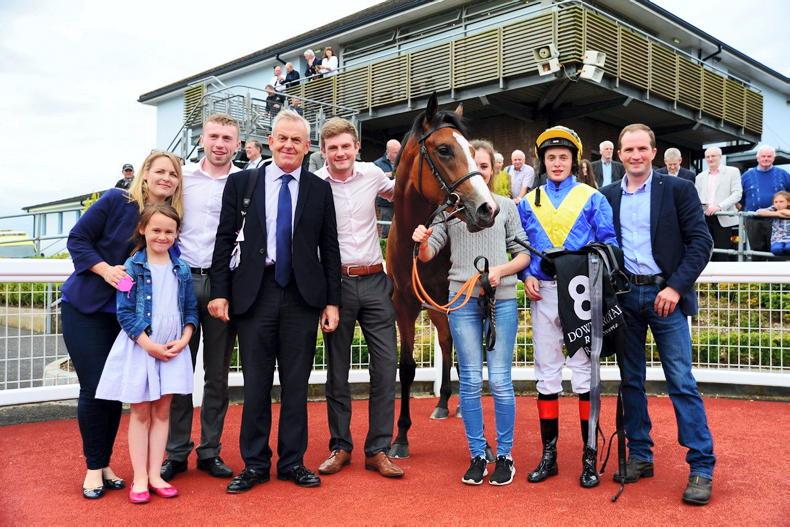How did you get into ownership?
My father William was always interested in racing. I grew up in an era where the whole family went to the Irish Grand National at Fairyhouse on Easter Monday, the first day of the flat in Baldoyle, or a day in Bellewstown in the summer. Hitching a lift was a very common form of transport in those days!
My first experience in racehorse ownership was with a group of local lads from east Meath in 1989 where we bought a horse off Tom McCourt in Stamullen as he was just getting started training. The horse was called Corporate Raider and he turned out to be very lucky for us, winning three times over the summer. He won in Bellewstown, Dundalk and Tipperary, and he fell in the lead at the last in Galway. Our most recent winner Tara Power at Dundalk was extra special as myself, Karl Davis and Ivan Clarke own the mare Belle Mare Plage and this was her first foal to race. Ivan’s brother Keith Clarke trains him.
What was your best day at the races?
I have been lucky enough to have some memorable days racing. When Corporate Raider won at our local track Bellewstown that was very special, he was favourite and it seemed everyone in the place backed him. In 2016, we had a two-year-old filly, Noble Dancer, win on her debut at 50/1, beating two previous winners – that was just off the charts.
Our recent Barney Curley charity race day at Bellewstown was an unbelievable success; Frankie Dettori was so accommodating and generous of his time as were Jamie Spencer, Tom Queally and Shane Kelly. It was fantastic to see racing portrayed in a positive light, we raised over €100,000 for Barney’s charity Direct Aid for Africa. This was a very special and memorable day.
Drawbacks being an owner?
Being involved now for over 30 years I am well aware of the risks and the unpredictable nature of horse ownership. Fundamentally you have to appreciate that any “investment” is at risk.
It’s no different to any other hobby like golf or sailing, you’re in it for the enjoyment. You get involved for the fun and the unpredictable nature of the sport when you’re operating at the lower end of the spectrum, looking to overcome the odds! Getting a horse to the track to run is an achievement in itself and that needs to be understood up front. There is no other sport where the small and the big owners can compete in the one arena.
Which racecourse in Ireland treats owners the best and why?
The big tracks are great on the big days but can be a bit soulless or lifeless on the quieter days. The smaller tracks can be very enjoyable in their unique way. I do believe greater efforts need to be made to get crowds back, this is one of the many challenges facing racing. All syndicate members should get general admission access when they have a runner, capped at 20. There are ways to validate who is actually a syndicate member.
Flat or jumps, which do you prefer?
I have to say I love the five-furlong sprints at Bellewstown, they are very exciting, horses going full tilt down the Hill is an exhilarating experience!
Flat racing tends to be held on warmer days which helps attract crowds and generates an enjoyable social occasion – very important in how racing is marketed.
What do you look for in a trainer?
Being forthright, honest and a good communicator is essential. Keith Clarke goes out of his way to keep Karl and me informed. We can go to the Magnier’s gallops in Skryne to see the horses working. We can see the horses improving as they get fitter and get closer to having a run. I really enjoy this. Similarly watching horses work up the Old Vic on the Curragh is a brilliant experience early in the morning. This builds the excitement and sense of expectation towards when they eventually run on the track. Keith sends us videos of the horses regularly as well.
Having a trainer who is local definitely adds to the experience, as you are able to visit the yard regularly. You get to know the staff and see when the horse is good form and ready to perform to the best of their abilities.
What improvements would you like to see racecourses in Ireland make? Continue to focus on the simple things. At Bellewstown we allocate various committee members to specific tasks on race days like having someone to meet and greet owners and sponsors when they arrive, and making sure prize presentations are properly managed for winning connections in the parade ring. Bringing winning connections for a celebratory drink and to watch a rerun of the race enhances the win, which for some is a once-in-a-lifetime experience. Just really making them feel valued and appreciated for their attendance and support.
Without owners and sponsors we don’t really have a viable product.
How do you think the current crisis will impact on racing in general?
I have to say racing has proven to be incredibly resilient during the crisis; horse ownership has held up very well.
Owners and sponsors have been very loyal which needs to be acknowledged. Racing being predominantly an outdoor activity helped to portray the sport in a healthy perspective during the pandemic.
What can trainers or HRI do to encourage keeping horses in training?
As the majority of horses in training are in the 45-to-70 handicap rating on the flat it’s important that the racing calendar reflects this reality. Owners want to be able to see their horses run.
On a macro level, I strongly feel that the 11 recommendations in the recent Oireachtas committee report need to be implemented in full so that the Irish bloodstock industry can retain its global reputation as being a world-class entity in which to breed and race horses.
Significance of your colours?
We picked colours that are easily identifiable, which as my son Peter says, is always easy if your horse is in front!
Buying a horse, what do you look for?
I tend to be drawn to stallions that I like who were consistent performers during their racing careers, not necessarily world beaters, that they had a sound temperament. I also like mares who were genuine performers and who consistently breed sound racing stock. Then you have to narrow it down to what options fall into your budget. After that I would leave it to Keith and Ivan to inspect them physically for conformation, temperament, etc.
What horses do you have in training?
Tara Power with Keith Clarke, Karl has a few in his own name also Tenth Amendment and Wish Me.
What’s next on the agenda?
Tara Power is on a well-earned break; he will be trained for a campaign on the turf in 2022 all going well.
Have you any young horses to look forward to?
Yes we have a full-sister to Tara Power who is being broken as we speak, so the dream starts again! I also am a partnership in another beautiful blacktype mare called Copper Kay, she had a foal in 2020 that sold very well. She is in foal now to Poet’s Word – hope springs eternal!
What do you do with your racehorses when their racing days are over?
We work with the trainer to ensure the horse finds a loving and caring home.
What would help to make Irish racing more competitive for the smaller owner/trainer?
Providing more opportunities for the lower-grade horses so that smaller owners have a more realistic chance of getting a run and hopefully some return for their investment. I will say the winter programme at Dundalk has helped a lot in this regard. Claiming races have proven to be very popular, more of these would help.
What advice would you give to someone thinking of becoming an owner?
Do plenty of research before making any decisions, explore what trainers are in your locality, go and visit them and get a sense as to what their philosophy is towards training.
Learn what the all-inclusive costs are involved in ownership before making any decisions.
I also think there is a huge opportunity to replicate the success of racing clubs and syndicates in bloodstock.
I am delighted to hear that the Stallion Trail is being reinstated in January 2022; this is a fantastic way for prospective owners and breeders to get insights into the breeding end of the industry and hopefully find a willing breeding partner to work with. The more investment we can attract into any aspect of the bloodstock industry can only be good.
In Britain I believe there is a tax incentive for this kind of investment which would be good to replicate here.
Jack Gogarty was in conversation with Olivia Hamilton<


 This is a subscriber-only article
This is a subscriber-only article
 It looks like you're browsing in private mode
It looks like you're browsing in private mode





SHARING OPTIONS: